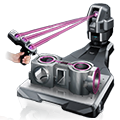Measuring Perpendicularity
When measuring perpendicularity, you are checking how perfectly the target is perpendicular to the datum (reference plane or line).
Sample Drawings

Using a Square Ruler and Feeler Gauge

- a
- Measure this gap using a feeler gauge
- b
- Target
- c
- Square ruler
- d
- Surface plate
Hold the square ruler against the target. Measure the gap between the square ruler and the target using a feeler gauge or pin gauge.
This gap indicates the perpendicularity.
DISADVANTAGES
Accuracy is low due to the simplicity of the measuring tools used. This method cannot be used when the measurement surface is not perpendicular to the surface on the surface plate.
The measurement data needs to be handwritten or manually input.
Using a Coordinate Measuring Machine (CMM)

- a
- Target
- b
- Surface plate
Set the datum by putting the stylus on multiple points on the datum plane (surface plate), and then measure the perpendicularity by putting the stylus on the measurement plane (target).
This enables accurate measurement even when the target’s measurement surface is not perpendicular to the surface plate.
It is also possible to measure the perpendicularity of axes of cylinders, bores, and circular cones.
- Measurement screen
-

- a
- Reference element (plane)
- b
- Target element (cylinder)
- c
- Perpendicularity measurement result



